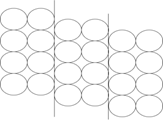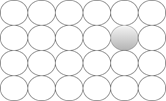This set of Engineering Materials & Metallurgy Multiple Choice Questions & Answers (MCQs) focuses on “Plastic Deformation”.
1. Which of the following represents the slip mode of plastic deformation?
a) 
b) 
c) 
d) 
View Answer
Explanation: The first image shows an ordinary crystal lattice. The second image shows the mechanism of slip where a part of the crystal slides over another. The third image shows the twinning mode of plastic deformation in which the atoms rearrange themselves to form a mirror image. The last image shows a defect.
2. What is the SI unit for the stress of a material?
a) N
b) N m
c) N m-1
d) N m-2
View Answer
Explanation: Stress is defined as the internal forces acting in a material. The various types of stresses are shear, tensile, yield, and ultimate tensile strength. All these stresses are defined as Newton/meganewton per square meter.
3. The process of increasing strength of a material by changing grain size known as __________
a) Grain boundary strengthening
b) Work hardening
c) Solid solution hardening
d) Precipitation hardening
View Answer
Explanation: Grain-boundary strengthening is the technique of increasing the strength of materials by changing their average crystallite size. This is otherwise known as Hall-Petch method. The Hall-Petch constant is written in the form of MN m-3/2.
4. What is the value of Boltzmann’s constant?
a) 8.314
b) 1.38 * 10-23
c) 1.38
d) 8.314 * 10-23
View Answer
Explanation: Boltzmann’s constant is associated with the kinetic energy of gas particles. It is denoted as gas constant divided by Avogadro’s number. The value of Boltzmann’s constant is 1.38 * 10-23 J K-1 and that of the gas constant is 8.314 J mol-1 K-1.
5. At what value of the index of strain rate sensitivity does the material behave superplastically?
a) 0
b) 0.2
c) 0.4 – 0.9
d) 1.0 – 1.2
View Answer
Explanation: The relationship between stress and strain rate can be expressed as σ = A ϵm. Here, m represents the index of strain rate sensitivity. For m = 0.4 – 0.9, the material exhibits superplastic behavior.
6. What is the slip plane for an FCC crystal?
a) {110}
b) {111}
c) {112}
d) {123}
View Answer
Explanation: A slip plane and a slip direction constitute a slip system of the material. FCC crystal exhibits slip plane {111} in the slip direction <110>.
7. How many slip systems are present in a NaCl crystal?
a) 3
b) 6
c) 12
d) 18
View Answer
Explanation: A slip plane and a slip direction constitute a slip system of the material. Both FCC and BCC crystals have 12 slip systems, while HCP crystals have only 3 slip systems. A NaCl crystal has 6 slip systems.
8. According to ________ five independent systems are required to maintain the reliability of grain boundaries.
a) Hal-Petch principle
b) Mohr-Coulomb theory
c) Tresca criterion
d) Von Mises criterion
View Answer
Explanation: In polycrystalline materials, a slip must be accommodated by a slip in adjacent crystals so that the grain boundaries remain continuous. According to the Von Mises criterion, at least five independent slip systems are required to maintain the integrity of grain boundaries during plastic deformation.
9. What is the CRSS value of a copper crystal?
a) 0.5
b) 0.75
c) 5
d) 15
View Answer
Explanation: CRSS is defined as the critical resolved shear stress of a material. For a copper crystal, it has an FCC structure and a CRSS value of 0.5. The CRSS values for aluminum, nickel, and iron and 0.75, 5, and 15 correspondingly.
10. What is the Hall-Petch constant for Iron?
a) 0.068
b) 0.11
c) 0.71
d) 1.77
View Answer
Explanation: The grain-boundary strengthening method is otherwise known as Hall-Petch method. The Hall-Petch constant is denoted as k and has a constant value of 0.71 for Iron. This constant for aluminum, copper, and molybdenum is 0.068, 0.11, and 1.77 in that order.
Sanfoundry Global Education & Learning Series – Engineering Materials & Metallurgy.
To practice all areas of Engineering Materials & Metallurgy, here is complete set of 1000+ Multiple Choice Questions and Answers.
If you find a mistake in question / option / answer, kindly take a screenshot and email to [email protected]
- Apply for Metallurgical Engineering Internship
- Practice Metallurgical Engineering MCQs
- Check Engineering Materials Books
- Check Metallurgical Engineering Books
